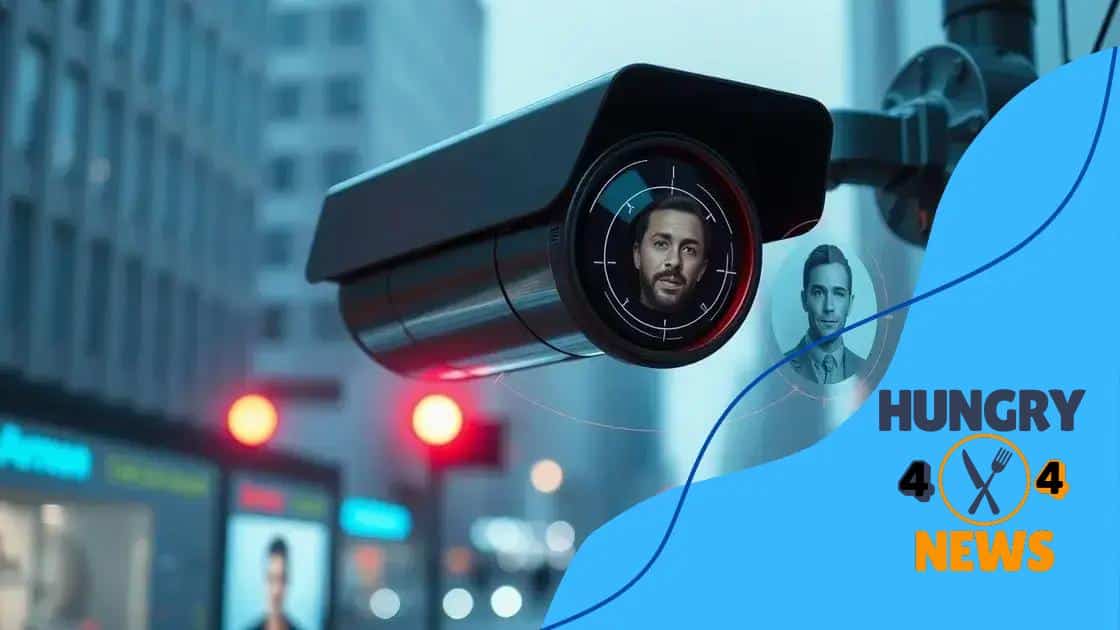The role of facial recognition in enhancing public safety

The role of facial recognition in enhancing public safety includes improving law enforcement identification, increasing security measures, and addressing ethical considerations regarding privacy and data usage.
The role of facial recognition in enhancing public safety is becoming increasingly important in today’s world. Have you ever considered how this technology impacts your community? Let’s dive into its benefits and complexities.
Understanding facial recognition technology
Understanding facial recognition technology is essential as it becomes increasingly integrated into our daily lives. This technology uses algorithms to identify or verify a person’s identity by comparing their facial features with a database. It is not only a fascinating field of study but also a valuable tool that impacts security measures and personal privacy.
How Facial Recognition Works
Facial recognition technology relies on complex algorithms to analyze facial features. It involves several steps:
- Image capture via cameras.
- Facial mapping to extract features.
- Comparison against stored facial data.
The accuracy of facial recognition systems has improved significantly over recent years due to advances in machine learning and data processing technologies. However, it is important to recognize that this technology operates under various conditions that can affect its performance.
Applications of Facial Recognition
Facial recognition is used in many fields, such as:
- Law enforcement for identifying suspects.
- Security systems for access control.
- Retail for customer engagement and security.
As we examine these applications, it becomes clear that facial recognition technology offers both benefits and challenges. For example, while it can enhance public safety, it also raises significant ethical questions regarding privacy and consent.
Ultimately, understanding how this technology functions helps us appreciate its capabilities and limitations. By being informed, we can navigate the discussions surrounding its use and implications more effectively
Benefits of facial recognition for public safety
The benefits of facial recognition for public safety are becoming more apparent as communities adopt this technology. By utilizing advanced algorithms, authorities can enhance security measures while also improving response times during emergencies.
Increased Security Measures
One major advantage is the ability to bolster security in public spaces. Security cameras equipped with facial recognition technology can:
- Quickly identify individuals on watch lists.
- Help prevent crime before it occurs.
- Facilitate real-time alerts to law enforcement.
This proactive approach not only aids in crime prevention but also creates a sense of safety within the community. Knowing that there are enhanced surveillance systems can deter potential offenders from committing crimes.
Efficient Emergency Responses
Another benefit is the improvement it brings to emergency response efforts. In situations where time is critical, facial recognition can:
- Assist in locating missing persons.
- Identify victims and suspects rapidly.
- Streamline communication between various emergency services.
With the ability to quickly analyze data, first responders can make informed decisions that can save lives. Furthermore, integrating this technology into existing systems allows for greater efficiency and collaboration between agencies.
Ultimately, as communities embrace facial recognition for public safety, they can enjoy the dual benefits of enhanced security and more effective emergency management. Balancing these advantages with ethical considerations is crucial, ensuring that while safety is prioritized, individual rights are respected.
Ethical considerations and privacy concerns

When discussing ethical considerations and privacy concerns surrounding facial recognition technology, it is vital to think about how this tech affects our daily lives. While it offers security benefits, it simultaneously raises significant questions about our rights and how our data is used.
The Right to Privacy
One of the primary issues is the right to privacy. Individuals may feel uncomfortable knowing that their faces are being constantly monitored in public areas. This technology can track movements and behaviors without consent, leading to a sense of being watched.
- Constant surveillance can lead to anxiety.
- People may alter their behavior when they know they are being recorded.
- Concerns about who accesses this data and how it is used.
As communities adopt facial recognition, it is crucial to establish guidelines that protect individual privacy while still allowing for safety innovations.
Data Security Issues
Another concern revolves around data security. Once facial data is collected, it is stored in databases that can be vulnerable to breaches. If unauthorized individuals gain access, they could misuse this sensitive information.
- Enhancing data protection measures is vital.
- Transparency in how data is collected and used should be a priority.
- Establishing regulations to protect citizens must be part of any implementation plan.
Society must navigate these ethical considerations to strike a balance between using facial recognition for public safety and upholding our ethical standards.
Real-world applications of facial recognition
Facial recognition technology has numerous real-world applications that enhance both security and everyday processes. This technology is being utilized in various sectors, showcasing its versatility and effectiveness.
Law Enforcement
One of the most prominent applications is in law enforcement. Police departments around the world use facial recognition to identify suspects quickly. This functionality helps:
- Locate missing persons.
- Identify criminals in real-time.
- Streamline investigations with data access.
This rapid identification can lead to quicker arrests and improved public safety.
Retail and Business Security
Another significant application is in retail environments. Stores employ facial recognition to:
- Monitor customer behavior and preferences.
- Detect shoplifters by matching faces to databases.
- Enhance customer service by recognizing loyal patrons.
These insights allow businesses to tailor their approaches to customers, improving the overall shopping experience.
Event Security
Facial recognition is also valuable in ensuring security at public events like concerts and sports games. Event organizers use this technology to:
- Screen attendees against watch lists.
- Detect potential threats before they escalate.
- Facilitate faster entry with identity verification.
This application not only enhances safety but also promotes a smoother experience for attendees.
The applications of facial recognition technology are numerous and varied, affecting many aspects of our lives. As technology advances, more innovative uses are likely to emerge, further integrating this technology into different industries and environments.
Future trends in facial recognition and safety
Future trends in facial recognition and safety hold exciting possibilities as technology continues to evolve. As advancements in artificial intelligence and machine learning occur, we can expect significant improvements in how this technology is applied across various industries.
Enhanced Accuracy and Speed
One of the main trends is an increase in the accuracy and speed of facial recognition systems. Improvements in algorithms will allow for:
- Faster processing times for real-time identification.
- Greater accuracy in diverse conditions, such as lighting and angles.
- Reduced chances of false positives and negatives.
These enhancements will make facial recognition more reliable in critical situations, particularly in public safety scenarios.
Integration with Other Technologies
Another key trend is the integration of facial recognition with other emerging technologies. This can include:
- Combining it with cybersecurity measures to protect personal data.
- Using it alongside drones for surveillance purposes.
- Integrating it with smart city initiatives to enhance urban safety.
This interconnectedness will provide a comprehensive approach to safety, creating smarter environments for individuals and communities.
Emphasis on Ethical Practices
As the use of facial recognition grows, there will be a greater emphasis on ethical practices. Discussions about:
- Establishing regulations for data use and privacy.
- Implementing transparency in how data is collected and managed.
- Ensuring that algorithms are fair and unbiased.
These measures will be crucial for gaining public trust and acceptance of this technology in the future.
Overall, the future of facial recognition and safety promises innovative solutions that could revolutionize personal and public security. Being aware of these trends will help communities prepare for a safer tomorrow.
FAQ – Frequently Asked Questions about Facial Recognition Technology
What are the primary uses of facial recognition technology in public safety?
Facial recognition technology is primarily used in law enforcement for identifying suspects, enhancing security at public events, and improving retail security.
How does facial recognition impact privacy rights?
Facial recognition raises privacy concerns as it involves the constant monitoring of individuals, potentially without their consent, leading to feelings of surveillance.
What are some potential future trends for facial recognition technology?
Future trends include increased accuracy, integration with other technologies, and a stronger emphasis on ethical practices and regulations.
How can communities ensure responsible use of facial recognition technology?
Communities can ensure responsible use by engaging in discussions about privacy, implementing regulations, and promoting transparency in data usage.





